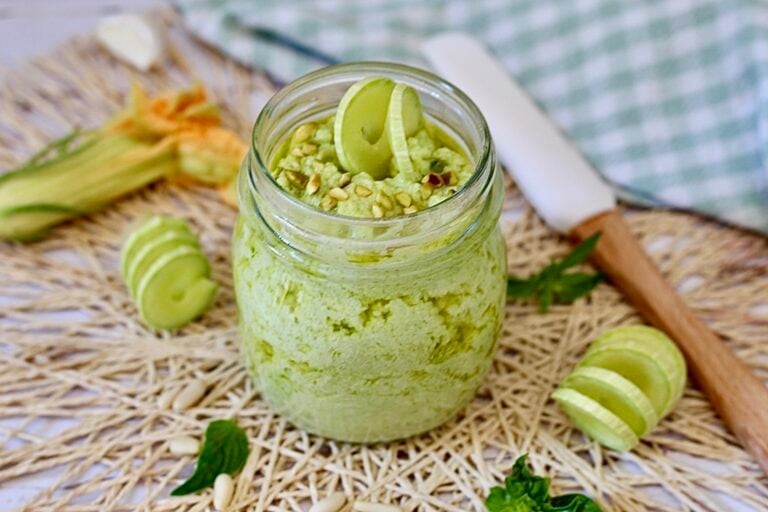Zucchini pesto is a condiment that represents a light and versatile alternative to the more well-known Genoese pesto. This preparation is distinguished by its velvety texture and delicate taste, characterized by the natural sweetness of zucchini, enhanced by a harmonious combination of fresh and aromatic ingredients.
Zucchini, summer vegetables rich in water and delicate flavor, form the base of this pesto. Their soft texture and slightly sweet flavor perfectly combine with the delicate taste of pine nuts, which can be replaced by almonds or walnuts.
They are the crunchy and slightly oily component that gives the delicacy of zucchini a note of richness and depth.
The cheese, often a combination of Parmigiano Reggiano and Pecorino Romano, brings a complex savoriness and a creamy texture that further enriches the sauce. Garlic, used sparingly, adds a touch of intensity that enlivens the taste without overpowering the other ingredients.
A distinctive aspect of zucchini pesto is its versatility. The sauce can be served cold or slightly warmed, adapting to a variety of dishes.
It is ideal for dressing pasta, especially short formats like fusilli or trofie, where the pesto can penetrate the pasta cavities, enhancing its flavor. Besides pasta, zucchini pesto is also suitable as a dressing for grain salads, like farro or barley, or as a spread for bruschettas and crostini.
The color of this pesto is a soft green, almost pastel, reflecting the freshness of the ingredients used. Its consistency is silky, thanks to the presence of extra virgin olive oil, which blends and binds all the elements into a smooth and enveloping cream.
Finally, the zucchini pesto represents a perfect solution for those looking for a lighter condiment without sacrificing taste. Its lightness, combined with the freshness of the ingredients, makes this sauce particularly appreciated during the summer season when zucchinis reach their peak flavor and quality.
I also recommend

- Difficulty: Very Easy
- Cost: Inexpensive
- Preparation time: 10 Minutes
- Cooking methods: No Cooking
- Cuisine: Italian
- Seasonality: Spring, Summer, and Fall
Ingredients for Preparing Zucchini Pesto
- 10.5 oz zucchini
- 1.4 oz pine nuts
- 3/4 cup extra virgin olive oil
- 1.4 oz pecorino
- 1.8 oz Parmesan
- 1/2 clove garlic
- 1/2 tsp fine salt
Tools
- 1 Mixer
- 1 Grater
- 1 Jar
- 1 Strainer
- 1 Bowl
Steps for Preparing Zucchini Pesto
For the pesto, it is advisable to choose fresh zucchinis, small or medium in size. These zucchinis tend to have a more tender flesh and a sweeter taste.
Wash them thoroughly under running water to remove any soil residues.
After washing, remove the zucchini ends. If you wish, you can partially peel them for a smoother pesto, but keeping the skin adds fiber and a more vivid green color.
Grate the zucchinis into a bowl with a vegetable grater.
Place them in a strainer, season with salt, and let rest for about twenty minutes to remove excess water. Then squeeze them energetically with your hands.
In an mixer or a blender, add the chopped zucchini, pine nuts, garlic (if desired), cheese in pieces or already grated, and extra virgin olive oil. Start blending the ingredients intermittently, to avoid overheating them and preserve the bright green color of the pesto. Continue blending until you achieve a smooth and homogeneous consistency. The pesto should be creamy but not too liquid. If necessary, you can add more oil.
If you want a touch of acidity, you can add a few drops of lemon juice, which also helps preserve the green color of the pesto. I garnished with pistachio crumbs and a zucchini curl.
Zucchini pesto can be used immediately as a pasta sauce, spread on bruschetta, or as a dip for meat or fish dishes. If using it for pasta, save some cooking water to better mix the pesto with the pasta.
Dairy-Free Option: For a vegan version, you can omit the cheeses and replace them with nutritional yeast flakes, which give a cheesy flavor, or with a combination of almonds or cashews, previously soaked and blended with the other ingredients.

Storage
Storage: If you don’t use the pesto right away, transfer it to a clean glass jar. Cover the surface with a layer of extra virgin olive oil to prevent oxidation. Close the jar and store the pesto in the refrigerator. It will stay fresh for 2-3 days.
Freezing: For longer storage, you can freeze the zucchini pesto. Freezing is an excellent method to preserve the flavor and color of the pesto, which can last up to 3 months in the freezer.
It is advisable to freeze the pesto in small portions, using an ice cube tray or small plastic or silicone containers. Freezing the pesto in portions will make it easier to thaw only the amount needed, avoiding waste.
Pour the pesto into the ice cube trays or containers, leaving some space for expansion during freezing. After filling the trays, cover with a thin layer of extra virgin olive oil to protect the pesto from air. Once frozen, transfer the pesto cubes to a freezer bag, removing excess air, and place them in the freezer.
Thawing: When you want to use the pesto, simply transfer the desired amount from the freezer to the refrigerator and let it thaw slowly. For quick use, you can also defrost the pesto at room temperature or directly in the pot with hot pasta.

